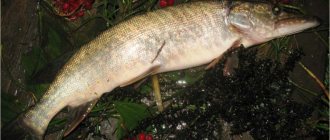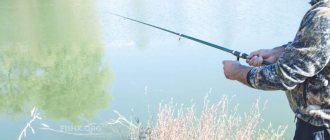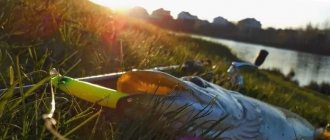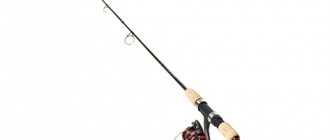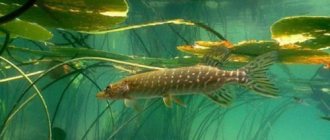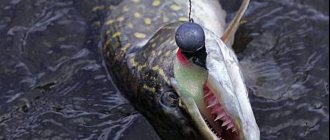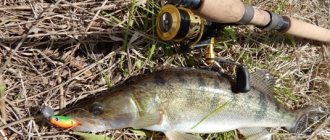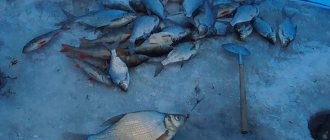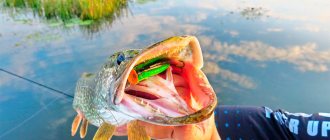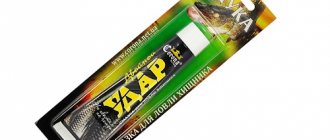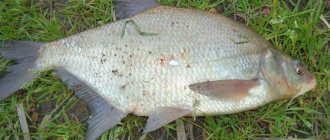Catching pike at night with a spinning rod has few fans, and some fishermen are completely perplexed that this is possible. Most consider the toothy beast to be an exclusively diurnal predator that hunts only during daylight hours. However, in fact, it feeds in the dark and sometimes even more actively. The fact is that in pike one of the main organs with which it hunts is the lateral line. She is able to clearly determine the location of prey precisely because of it, without relying on vision. Therefore, it is not surprising that in the dark a fish can successfully attack a fry that has fallen into the zone of “influence” of a toothy predator without missing a beat. As you can see, pike is capable of hunting at night. And she does this quite successfully. It is possible to catch it in the dark. But the predator does not behave actively on every body of water. In some places she consistently takes bait, in others she bites extremely rarely and haphazardly. Experienced spinning anglers know the habits of the spotted beast well and understand where, when and what to fish with.
When to catch?
It is advisable to open night fishing for pike when stable warm weather arrives. In some regions it begins to bloom at the end of May; in some regions this period occurs only in the second half of June. Fishing at night in the spring is associated with the behavior of a toothy predator and a high water level. In summer, pike are active at different hours of the night. This is related to the temperature of the water. So at the beginning of the season, she feeds immediately after sunset and in the predawn hours. In July, when it is sultry outside during the day, the fish show interest in baits closer to twelve. Advice! At prolonged, stable high temperatures, the predator can completely ignore the bait during the day, but then it literally tears it apart throughout the night, and with dawn its bite subsides again. With the onset of autumn, pike are less likely to be caught at night. This can be explained by cooling and the establishment of conditions more favorable for hunting during the day. True, in the dark it still feeds, and in some reservoirs seasoned fishermen successfully catch it until the end of November.
Ideal conditions for catching pike at night are: • new moon or cloudy sky; • warm weather; • lack of wind. The best pike bite at night is observed during the new moon, when the pond is not illuminated by anything. During the full moon, it has been observed that the predator attacks bait extremely reluctantly, although exceptions do occur. In windy weather, there is nothing to do on the shore at night, since all the fish, not only pike, wait out the bad weather and do not feed.
Advantages and disadvantages of live bait fishing
Advantages
- You can fish in hard-to-reach, overgrown places where it is problematic to do this with a spinning rod.
- There is no need to spend money on bait, you caught live bait and all the problems.
- Cheap gear, which is easy to make yourself from scrap materials.
- The gear can be left overnight or for several days, well secured on the shore.
- You can fish a reservoir with several homemade products at once.
Flaws
- hassle with live bait - you need to catch it, and if you bought it, then save it;
- installation of gear requires a boat, especially for passive pike;
- this is passive fishing, devoid of sports excitement;
- assembly is a hassle, usually the spinning rod is already ready for fishing. You only need to attach the bait.
Summer fishing with live bait is one of the most productive ways to catch pike. Yes, it doesn’t have the same dynamics that spinning fishing provides, but it is interesting in its own way and often brings good trophies.
In what places to look for pike at night?
On a hot summer day, the toothy beast stays in vast shallow areas, abundantly covered with algae, and on channel edges, clinging to the bottom. However, at night, it changes its positions and moves to clean areas with hard pebble, sandy or rocky soil. You need to look for it in the following characteristic areas: • sand spits and shallows; • coastal zones with a hard bottom near sharp coastal edges; • single flooded snags and tree branches located in the coastal zone; • shallow places with slow currents and pebble bottom. Pike is an unpredictable fish that can be found in any part of the reservoir. It often gets bitten when fishing for other fish. For example, when catching night pike perch, attacks by a toothy predator are possible, since it can be located nearby in the pits and behind the tubercles on the bottom. Therefore, it is advisable to use a steel or fluorocarbon leader to avoid cutting the bait. In autumn, pike also enter shallow water areas. But in this case, she visits the shallows close to the channel holes and pools, in which the predator gathers in the cold season. She likes to go to areas with a reverse or slow current, where small roach, silver bream, rudd and other small fish can concentrate.
Features of choosing gear
Pike is a strong, sharp fish that powerfully attacks the bait and quickly resists when hooked. If during the day the angler visually controls its movements, then fishing at night is much more difficult, and the spinner is forced to rely on his experience and intuition. It is often necessary to forcefully pull the fish towards the shore to avoid tangling or breaking the gear. At night, pike fishing is carried out at close range. In fact, most bites happen “underfoot.” All the grips are unexpected for the fisherman, which brings a lot of emotions and adrenaline. Therefore, gear must be prepared for such a development of events and able to withstand the onslaught of a large, ferocious predator. The rod is taken short, the maximum length should not exceed 2.40 meters. It must absorb pike jerks well and have a decent reserve of power, allowing for forced fishing. The best spinning rod for night pike will have a thick butt part and a thin movable tip, which reliably dampens any sudden movement of the predator. There are two main requirements for a spin-free reel for night hunting for pike: • High-quality line laying. She must wind the cord onto the spool without dips or humps. Otherwise, beards and dropped loops cannot be avoided, which in the dark can lead to the complete end of fishing due to the impossibility of untangling the thread. • Very sensitive brake. The friction mechanism must work flawlessly when the pike grabs. If the clutch does not work well, a sharp strong bite may cause the rod to break or the cord to break. It is better to give preference to a power reel, which has impressive traction performance. There is no need for high-speed speed, since you will mostly have to perform leisurely wiring. Since fishing is carried out mainly short-circuit, preference should be given to good quality monofilament fishing line, which can be used in spinning fishing. Thanks to its stretchability, it will absorb sharp jerks of the pike, which will help the friction brake of the reel and prevent the predator from tearing the tackle. Some anglers use braided line. This is most likely done due to the fact that the spinning angler does not have a separate set for night pike, and he uses his own universal gear, which he uses for hunting pike perch in the dark and fishing for other predators during the day. A leash to protect against razor-sharp pike teeth is a must. You can use the following options: • homemade “twisting” of steel wire; • fluorocarbon line; • purchased products;
• bends made with your own hands from leading material. The angler himself chooses which leash he prefers, since all options are reliable and effectively prevent the bait from being cut.
Preparing gear and devices
Fishing at night with a spinning rod will be successful if the fisherman takes the preparation of gear responsibly. Pike is a strong predator, has a powerful jaw and sharp teeth. She can break the spinning rod, break it, bite the fishing line in a split second. Therefore, the tackle must have a solid reserve of power and be prepared according to all the rules.
There is no point in using a long spinning rod at night. Fishing is carried out at a short distance, and the attack occurs almost under the shore. A rod up to 2.4 m long is easier to control and catch large fish. It should be powerful, absorb shock, and absorb shocks. Read here how to choose a spinning rod for pike.
A powerful and strong spinning reel will do. It is recommended to choose power options. Speed does not matter, and traction will allow you to fish out prey more efficiently.
- Line laying. The risk of tangling is greater at night than during the day, so installation should avoid grooves and bulges. Otherwise, there is a risk of beard formation.
- High quality braking system. The friction clutch must work flawlessly, otherwise strong jerks of the pike will lead to breakdown.
- Build quality. It is recommended to take products with the maximum number of metal components.
Line and leash
It is recommended to use monofilament as the main line. It will absorb jerks due to positive stretchability. Fishermen often use braided lines. But given their characteristics, this is not recommended.
It is imperative to equip the spinning rod with a leash. The sharp teeth of a pike will bite through the fishing line instantly. Using a leash will eliminate the possibility of losing the bait.
The following types of leashes are used:
- fluorocarbon;
- guitar string, steel wire;
- purchased leashes.
All options are reliable and will protect the bait from loss.
What devices will help when fishing?
It will be extremely difficult to do without some items when night fishing. These include:
Using a retriever will allow you to keep the necessary equipment nearby. This will be especially useful in the dark and will reduce the risk of losing accessories.
The yawner will allow you to hold the pike's mouth in an open position. When removing the hook, it will protect your fingers from your teeth.
With the help of a forceps, the hooks will be removed quickly without difficulty. The device is a clamp that securely and firmly fixes the tee when pulled out.
Ligrip is used to hook fish by the skin and pull it out of the water. At night it is better to use it than a landing net.
Best lures
To catch pike at night using a spinning rod, wobblers are used. Other types of baits are significantly inferior to them. It is important to choose models that have a rattle inside and make significant noise when wiring. Such objects are clearly visible to the predator, and she is more willing to attack them. Unlike pike perch, pike can be caught at night not only with a minnow. It attacks cranks, shads, joints and rattlins with equal success. The size is selected based on the potential weight of the predator. Most often, wobblers with a length of 7–12 cm are used.
Lures for night pike should not be near the surface. It is optimal to conduct it in the water column or closer to the bottom. At night, the spotted beast stands in the lower layers and rarely rises upward. Important! It is advisable to use wobblers with neutral buoyancy. This will allow the bait to freeze in one place, which will minimize the predator’s misses and increase the number of bites realized. The insertion of the wobbler should be slow. It is useful to make stops, holding the bait in place. The direction of movement must be chosen along the edge or across the coastline. This way, the object will remain in the pike’s attention zone longer and the likelihood that it will decide to bite will be maximum. To avoid unpleasant surprises at night, it is advisable to explore the intended water area during the day and determine the relief, the location of obstacles, promising casting points, select convenient approaches to the water's edge and the optimal areas in the coastal zone where the hooked pike should be brought.
Night spinning - obvious and incredible
Night fishing is not a new topic, but for most anglers it remains obscure or completely unfamiliar, and if it is associated with anything, it is with night fishing with donkeys. But in reality there are more sporting methods, one of them is spinning.
Objects and fishing seasons
Typical night trophies: pike perch, chub, catfish, pike and, oddly enough, asp. A single catch of rudd, perch, and ide is possible; it is quite possible to catch peaceful fish (bream, silver bream) with a spinning rod. Obviously, on rivers with a large species diversity and rivers in other climatic zones, night fishing with spinning rods and other species of fish is possible.
Effective night fishing with a spinning rod on rivers (with a natural temperature regime) begins after the flood, with the arrival of heat and warming up of the water.
The bite reaches its apogee in June-July, decreasing slightly in August, continues with some restrictions in September and ends by the end of October (if the ice has not formed, it can cover the first ten days of November). But the autumn “night shift” with the onset of frosts does not promise comfort. This fishing is for fans, and it is mainly focused on jig fishing for pike perch (and pike as bycatch).
The summer version of night fishing is fishing for pleasure (minimal pressure, comfortable temperature conditions, acuity of sensations, non-standard perception of everything that is happening...).
Places
Tactically, finding interesting places for night spinning is not difficult. It is determined by finding sections of the river with a strong current (for medium-sized rivers) and subsequent fishing of these sections. These are, first of all: jets, rifts, bridges, dams, narrowings and turns of rivers, places of confluence of large streams and tributaries. Night fishing in holes, just deep sections of the river, spits, in areas with laminar flow, even with the use of jig equipment is not always effective. For some reason, various kinds of seething waters, places where the current intensifies, reverses and whirlpools arise, in most cases turn out to be more promising and in demand.
On large rivers, night fishing spots can vary greatly, and you can hardly do it without a boat. It should be noted that the determining factor in some cases is the possibility of changing the fishing location, since out of 3-4 tested points, one or two will work, but at some interval.
Wobblers
With all the variety of possible night baits and even in some cases to the detriment of the result, I still prefer fishing with wobblers. There are several reasons. The bottom of the sections of the river where night fishing is usually carried out is almost always heavily cluttered - stones, logs, snags, man-made debris in the form of old piles, fittings..., and on top of all this there are meters of scraps of nets, torn cords and fishing lines. Tell me, how to fish here with spoons or jigs?
The wobbler has a fixed depth and the ability to surface, thereby forgiving both minor flaws and your temporary inaction during wiring. And the wobbler’s grip is higher, so missing the moment of a bite is often not critical.
An equally obvious point is the versatility (attractiveness) of wobblers as bait when catching different types of fish (plus additional acoustic capabilities due to rattles). In addition, bottom predators that are active at night (catfish, pike perch), not to mention pelagic ones (chub, asp, pike, etc.), in most cases prefer to hunt either near the surface or in the water column, and fishing with wobblers in these horizons are most effective.
The general requirements for wobblers used in night spinning are extremely simple: they must hold a stream, a given depth, and since frequent replacement of bait at night is inconvenient, if possible, have a size that is simultaneously interesting to different predators.
Deepening.
The stable operation of the wobbler at different current strengths allows, without any failures, to simultaneously move the bait in various ways (along the stream, across, at different angles, etc.). In this case, the predator, focusing mainly on the lateral line, under no circumstances loses sight of the “prey”, and the percentage of misses and idle grabs decreases accordingly.
A given fishing horizon is sometimes important when fishing for catfish and pike perch (rivers, reservoirs), since these predators, hunting in the water column or bottom layer (albeit at shallow depths), can, unlike the same chub, asp, pike, almost not react to low-depth bait.
Size.
The universal “night” size of a wobbler is a relative value, but if it is shad or minnow, then 6–7 cm is preferable; if it is a crank, then 5 cm, otherwise the same chub begins to miss or almost stops responding to the bait. With a smaller wobbler, catfish and even pike lose interest in the bait.
If it is desirable to catch a specific predator, or the fish of other species are unlikely to catch, the size of the wobbler is adjusted up or down, but in this case the versatility of the bait is simply not required.
Color.
The color of wobblers in a night spinning rod is not a primary thing, but it should be recognized that baits of yellow and lemon colors are sometimes a little more effective, although they are more noticeable to both the fish and the angler in any case. The presence of all kinds of “rattles” in the body of the bait, although generally welcomed by the fish, does not provide a clear advantage when fishing at night, and you should not bother about it.
I consider the use of very expensive wobblers unjustified, but special attention should be paid to the quality of the tees.
Weather and other factors
A very interesting aspect of night spinning fishing is related to natural light - the presence of the moon in the night sky, bright nights in June.
Light nights, for obvious reasons, are primarily convenient for the fisherman, but the fish, especially in the absence of clouds, do not always perceive them with a bang. Moreover, the harsh light of the moon in the full moon phase (2-3 nights) can put the fish into a stupor and, in the absence of dense clouds, a bite can only be achieved in shaded areas (trees, dense tall bushes growing along the banks).
But the week before the full moon, when the first half of the night is light, and ten days after, sometimes completely atypical nocturnal predators - pike and asp - become more active.
However, both pike and asp are quite tolerant of the lighting of the bridge and the diffused light of a lantern from a nearby village.
A negative factor in night fishing is the “sky show” in the form of thunder, thunderstorms, flashes of lightning, even at a distance of several tens of kilometers.
“Pioneer summer” does not promise anything good either - at night, sexually mature offspring of both sexes are pathologically drawn to water (screams, fires, loud music...).
Light rain, a sudden change in weather (without cold snap) are not at all critical for a successful night shift, and in some cases they are even favorable. Heavy fog (usually from August, cold nights) is more of an inconvenient factor than a critical one, and the chub sometimes even like it.
Zander
In many cases, the number one trophy of the night. During a night hunt, pike perch can behave differently; in places with a large concentration, it, squeezing the bleak, robbers openly and behaves very noisily; in places where its number is small, the pike perch is more careful. It sneaks up from below and stands under the stream or at the border (sometimes quite deep and at a considerable distance from the shore), can go ashore and patrol it, without giving away its presence in any way. In these cases, it does not tolerate the close proximity of catfish and large pike.
The bite can be hard, but more often it is a hang or a light poke (the scratching of bats on a vibrating cord is very similar to the grip of a pike perch), hooking is needed in any case.
Night spinning is obvious and incredible. Alexander Gurov Some preference is given to small minnows with small amplitude, high-frequency play, although he will not miss other wobblers that are clearly not of a zander size. Sometimes the use of rattlins is effective.
The wobbler is thrown or floated downstream to the desired place, it is very important that the depth is correct, the wiring is in most cases uniform with stops or twitching elements.
When casting with a rattlin, the retrieve is performed like a jig step, but in a slower manner.
When fishing, a pike perch may get behind an obstacle (stone, reinforcement, etc.) and in this case it is better to let it go a little. On a hard bottom and open shallows (less than body length), even a medium-sized pike perch puts on a show - it bends sharply on its tail, makes candles, shakes its head, knocking out and sometimes tearing off the wobbler! It should be noted that in the fall, pike perch, remaining very active at night, comes out to seethes and shallows less often.
Chub
An outspoken night robber, during the spawning of bleak (late May - early June) it is more impudent than asp and pike perch, prefers various kinds of seething waters and areas with strong currents, in their absence sticks to grasses, reed walls, bushes hanging over the water. The lobasy is not very picky at night, sometimes it even rushes at large baits, but when attacking a wobbler from any position, it consistently falls only on baits of the appropriate size.
“Daytime” chub wobblers can be used with the same success at night. The methods of placing and animating baits are the same as during the day; a chub, awake at night, does not lose its lightning-fast reaction to everything that happens. Just like pike perch, it does not tolerate the close proximity of pike and catfish and can leave its area when the latter appear.
When fishing at night (especially when shallow), it behaves frantically, and after being removed from the water, it often injures the hands of a careless fisherman with the hooks of the wobbler.
The grip is almost always very tight, which results in quite frequent extension of the tees (replacing hooks with larger ones can distort the play of the wobbler to the point of failure), and if a large chub bites (which happens more often at night than during the day) and the clutch is tightened, even the cord may break. Like pike perch, chub can feed at exits, and then bites follow one after another, but for a limited time. Or eat throughout the night, in which case the seizures follow at varying intervals.
In the case of an idle grip, changing the bait helps a lot; even a single chub often does not refuse to try something different literally on the next cast. A couple of idle bites or a subsequent disappearance very alarms the chub or the entire flock, and as if on command, it stops responding to any bait.
The chub responds positively to some attractants, but in this case the bite is different; following the scent trail, the chub sneaks up and does not attack, but literally tastes the bait with its lips alone! There is a feeling as if someone is rubbing or scratching the wobbler; such a bite also happens with very slow retrieving, but hooking in both cases is often ineffective. A single chub, together with small pike perch, opens the night season on the rivers with the beginning of May first, and the last to finish it, if it’s warm, then in October.
Som
Of course, this is a nocturnal predator. But it would be more expedient to talk not about catching catfish, but about how to achieve its grip. And this is not only because today the number of catfish in our rivers is small, but because the catfish is the master of the river, and it is advisable to take its possible bite extremely seriously. A bite from even a medium-sized mustachioed fish in conditions of limited visibility, limited movement, and strong currents leads (if you understand who you are dealing with) to an injection of a fair amount of adrenaline.
If you manage to pull yourself together, then a subsequent struggle with an unpredictable ending is possible. If they fail, there will be a quick breakdown of the spinning rod or a broken cord, in extreme cases, an unexpected swim, but for lovers of elegant gear and glamor this is almost guaranteed.
Catfish begin to be caught on donkeys already in April. In May, as the water warms up, the mustachioed one becomes significantly more active - it crawls out of holes and begins to rummage around everywhere, and at night, in search of leucorrhoea, it also examines the surface layers of the water, open shallows, and areas with strong currents. Here his grasp is very possible.
This activity persists for two to three weeks, then it decreases, but after spawning, the probability of a bite by a mustache remains quite high until mid-August, and if it is warm, then until September. It should be noted that, contrary to popular belief, catfish can be active in frankly cold weather, but in my practice this only happened in May-June.
Even in the dark, the catfish reveals its presence with powerful splashes or spectacular turns, but sometimes it sneaks up and, at the border of the stream and the return, quietly stands on combat duty; at night it can crawl out onto the open aground and guard its prey there. In the summer of 2008, I stepped on such a “sentry”, and when he took me, both of us were scared...
Another variant of the mustachioed hunt is when he finds a small thing standing in the current and, over and over again, opening his mouth, simply rolls down on top of it. In all these cases, it is quite possible to slip him a wobbler, and as they say, half the battle is already done, but for a mustachioed one, the wobbler should be larger, with strong hooks and winding rings.
When fishing by casting, the bait is pulled uniformly with a minimum speed and, if the current allows, frequent stops. Catfish react well to wobblers with rattles; they can even repeatedly rise from the hole to the sound of a wobbler hanging in the current, although they often ignore the wobbler itself and only grab a bleak literally next to your musical bait.
Asp
Oddly enough, at night, especially if it is not very dark, from May to August this fish is caught consistently, and what’s more, large (3–4 kg) asp are caught. Usually - single, less often - 2-3 pieces.
From the end of the first ten days of May until June, having eaten up over the winter, the asp is especially fierce at night, but, being a cautious predator, in areas with weak currents and in the dark, he easily distinguishes a wobbler from the original (roach, bleak) and its capture is more likely Totally random.
On various types of seething waters he is less careful and does not disdain wobblers, preferring the same fast retrieve as during the day; with slow retrieve, sometimes he allows himself only a polite poke, and there may be three or four such empty pokes (!), until you guess for sure, that their author is an asp. Then you change the wobbler, make a quick retrieve and at some stage you receive a severe blow! The clutch squeals, the asp rushes, quickly reels in 15–20 m of cord, then stops, from this moment you can calmly begin landing it.
Another type of bite is also possible - in this case the grip is soft and neat (regular hang). The behavior of the asp during such a bite is also calm: short, smooth stretches with frequent stops, periodic shaking of the head (very similar to catching a small catfish).
Pike
At night, although it gives some preference to the presence of light, it is systematically caught; moreover, in addition to rivers, it is also caught on ponds, peat bogs, and reservoirs.
On rivers it approaches riffles, seething waters, even goes out into strong currents, but prefers not to cruise in search of prey, but to stand on “combat duty” behind some obstacle. Closer to dawn, but still in the dark, sometimes it begins to misbehave, giving itself away with loud bursts. Not catching it at this moment is the height of indecency, and it is advisable to free an interesting fishing area from the toothy one as quickly as possible.
Despite the significant size of its mouth, the pike, during a night attack, quite often misses, returns to the same place and after some time attacks again.
